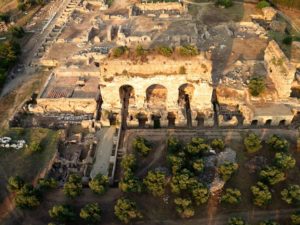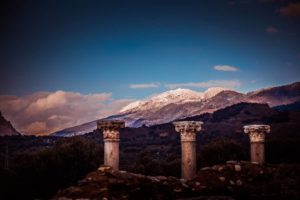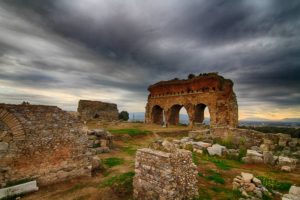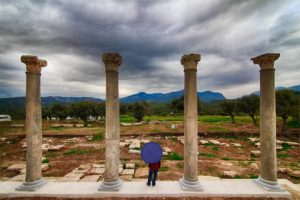Tralleis, the city of architects and physicians, the city of Seikilos, the first note music on earth
Tralleis is the city of architects and physicians. Anthemios the architect who built Hagia Sophia, and Doctor Alexandros who had an important place in the history of medicine were born and grew up in this city. Tralleis offers visitors the opportunity to see the excavation sites, taste the excitement while exploring the artifacts, touch the past, and experience the archeology which is located next to Aydin city center and excavated for 12 months of the year.
Tralleis Antique City lies between Mesogis (Chestnut) Mountain in the north and Büyük Menderes River in the south which is located in the area called Topyatagi to the north of Kemer District of Efeler district of Aydin.
History of the City
The city was founded by the Thracian tribes, the Thracians, and the Argos from the Peleponnes peninsula of Greece after the Doric migrations. Tralleis had to deal with wars and earthquakes and was renewed with the help of emperors. However, the economic center of gravity changed due to Istanbul being the capital and the trade of Tralleis was negatively affected. The city, which was physically transformed by Arab invasions, was conquered by the Turks in the 13th century and under Ottoman rule in the 15th century.
The 480-acre settlement area on the eastern slope of the city is within the borders of the military. It is known that civil and official architectural structures such as theater, stadium, temple and mint are also within the boundaries of this area. In addition to these, structures such as gymnasium – bath complex, church, villa and necropolis were unearthed during excavations.

Tomb of Seikilos from Tralleis
It was discovered during the construction of the İzmir – Aydin railway in 1883 and was built in 1-2 AD. The tombstone which belongs to a young man named Seikilos, lived in the vicinity of Tralleis in the 16th century.
As a result of this research, it was found out that this melody was the earliest known song. The words in the stele are as follows:
“Seikilos planted me, I am a stone statue, to keep the memory alive, my duty forever …”
The lyrics of the song are as follows:
Shine as long as you live,
Don’t worry about anything,
Life is short and time
Makes you pay one day…
Euter’s (pes) son Seikilos was made it when he was still alive.
What makes the inscription important is that there is a note on each syllable. Very few melodies came from ancient times in small pieces, and Seikilos was fully captured. Today, this work is exhibited in Copenhagen National Museum.
Research History
The excavations in the ancient city have been continued by Erzurum Ataturk University since 2017 which was initiated by the German Orient Committee in 1888.
Excavations in the Tralleis Ancient City revealed mainly gymnasium, latrina, shops and fountain, Colonnaded Street, villa, Episcopal Church, waterways, arsenal and necropolis areas.
Arsenal
Located 300 meters north of the Gymnasium structure, this structure was built on the northern slope of a valley leading to the Ancient Ephesus – Tralleis Road. The first floor of this three-storey building is thought to have been added to the Hellenistic period and the second and third floors were added to the building in later periods. While the height and width of the tunnel are kept wide at the entrance of the structure, contraction and descent are observed as it progresses along the tunnel. As it progresses from the main entrance of the building, it is observed that the tunnel is divided into branches and resembles the labyrinth.
Turkish Bath – Gymnasium Complex
Gymnasium is the name given to the structures in which young people receive their physical and social education in Ancient Greek and Roman societies. It is known that the construction of the Gymnasium of the Ancient City of Tralleis started in the 3rd century BC. In the middle of the 2nd century AD, a bathhouse was added to the Gymnasium and turned into a complex.
Tralleis Gymnasium has been destroyed and repaired many times as a result of severe earthquakes which is one of the biggest gymnasium in Anatolia. There is a bath section to the west of the building. The building called Uc Gozler “(Three Eyes) is the monumental western entrance of the bathhouse.
Latrine
Latrine is derived from the words “lavatrina” and “lavare” which means washing and it means toilet. In the middle is a fountain surrounded by columns. In front of the seats there is a channel with clean water flowing. To the east of Tralleis Latrine is a plastered clean water pool and the need for clean water is met here. The Tralleis Gymnasium Latine is known as one of the largest Roman Latrines in Anatolia with a capacity of 65 people. The finds indicate that latrina was used between the beginning of the 2nd century AD and the end of the 3rd century AD.
Production and Sales Points
The shops dated to the Late Roman – Early Byzantine periods were built adjacent to the north wall of the gymnasium – bath structure. The length of the shops in the east – west direction is 95.58 meters. There are 14 shops in total. There is a semi-circular fountain structure in the middle of the shops. The shops are arranged symmetrically, with seven shops on the right and seven shops on the left of the fountain.
Colonnaded Street
The construction of the colonnaded street to the north of the shops must have started after the earthquake in 26 BC. The colonnaded street was probably built together with the shops. Composite column heads appearing in front of the walls of the shops facing the street reflect the style of the 2nd century AD. This shows that the street was used in two periods. During the excavation season of 2014, four columns were restored with restoration projects.
Episcopal Church
The building is located in a dominant position between the Kemer District of Aydin and the gymnasium – bath complex. As a result of the excavations, the remains of the buildings that were built in two different periods were found. In the first building level, a church with three naves was built. After the collapse of this building, the second building was built as a monumental church with a cross plan (Episcopal Palace) and dates back to the Middle Byzantine Age.
Transportation
You can reach the ruins in Efeler district center with your private car or on foot.
Entrance
Visiting hours are between 09-00-17: 00 and entrances to the ruins of Tralleis are free of charge.




